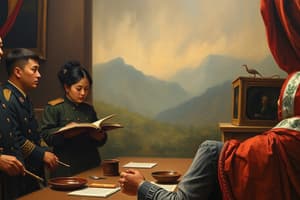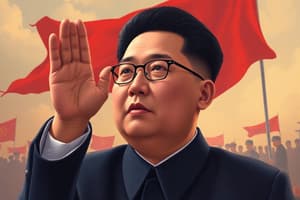Podcast
Questions and Answers
What critical decision regarding Korea was made in the final days of WWII?
What critical decision regarding Korea was made in the final days of WWII?
- Korea was granted immediate independence under a unified government.
- The United Nations was established to oversee the transition to democracy.
- The Soviet Union was given complete control over the Korean peninsula.
- Korea was divided along the 38th parallel, with the US and Soviet Union administering separate zones. (correct)
What was the primary reason elections were not held in Korea following WWII, leading to the establishment of two separate states?
What was the primary reason elections were not held in Korea following WWII, leading to the establishment of two separate states?
- Syngman Rhee and Kim Il-Sung jointly decided against holding elections.
- The United States and the Soviet Union could not agree on the terms and conditions for the elections. (correct)
- The United Nations declared that Korea was not ready for self-governance.
- The Korean people overwhelmingly voted against holding elections.
What action taken by the U.S. Secretary of State Dean Acheson, influenced North Korea to invade South Korea in 1950?
What action taken by the U.S. Secretary of State Dean Acheson, influenced North Korea to invade South Korea in 1950?
- Acheson announced a significant increase in military aid to South Korea.
- Acheson publicly threatened North Korea with military action if it made any aggressive moves.
- Acheson omitted South Korea from a speech outlining the defensive perimeter of the United States in Asia. (correct)
- Acheson called for the United Nations to impose stricter sanctions on North Korea.
How did the United Nations respond to North Korea's invasion of South Korea?
How did the United Nations respond to North Korea's invasion of South Korea?
What was the main reason President Truman relieved General Douglas MacArthur of his command during the Korean War?
What was the main reason President Truman relieved General Douglas MacArthur of his command during the Korean War?
What long-term impact did the Korean War have on the Korean peninsula?
What long-term impact did the Korean War have on the Korean peninsula?
How did Kim Il-Sung establish and maintain his power in North Korea after the Korean War?
How did Kim Il-Sung establish and maintain his power in North Korea after the Korean War?
What is Juche, and how did it influence North Korea's development?
What is Juche, and how did it influence North Korea's development?
What are gulags in the context of North Korea, and what purpose do they serve?
What are gulags in the context of North Korea, and what purpose do they serve?
How did the death of Kim Il-Sung in 1994 impact North Korea's political landscape?
How did the death of Kim Il-Sung in 1994 impact North Korea's political landscape?
What is Songun, and how did it shape North Korea under Kim Jong-Il?
What is Songun, and how did it shape North Korea under Kim Jong-Il?
What was the 'Arduous March' in North Korean history, and what caused it?
What was the 'Arduous March' in North Korean history, and what caused it?
How did the North Korean government respond to the famine during the "Arduous March?"
How did the North Korean government respond to the famine during the "Arduous March?"
Following the Arduous March, what did the North Korean government tell its citizens about aid given by the U.N.?
Following the Arduous March, what did the North Korean government tell its citizens about aid given by the U.N.?
What was the Agreed Framework between North Korea and the United States intended to achieve?
What was the Agreed Framework between North Korea and the United States intended to achieve?
What action did North Korea take in 2003 that heightened international tensions?
What action did North Korea take in 2003 that heightened international tensions?
What was the goal of the Six-Party Talks involving North Korea, South Korea, the United States, Russia, China, and Japan?
What was the goal of the Six-Party Talks involving North Korea, South Korea, the United States, Russia, China, and Japan?
How has North Korea's nuclear weapons program impacted its relationship with South Korea?
How has North Korea's nuclear weapons program impacted its relationship with South Korea?
Which country annexed Korea in 1910, maintaining control until 1945?
Which country annexed Korea in 1910, maintaining control until 1945?
What impact did Japan's control over Korea during WWII have on the Korean people?
What impact did Japan's control over Korea during WWII have on the Korean people?
What was Songbun?
What was Songbun?
Flashcards
Japanese Annexation of Korea
Japanese Annexation of Korea
Japan annexed Korea in 1910 and maintained control until 1945.
Korea During WWII
Korea During WWII
During WWII, Japan exploited Korea for resources and labor, including forced labor for men and comfort women.
38th Parallel
38th Parallel
The dividing line between North and South Korea, agreed upon by the U.S. and Soviet Union after WWII.
Kim Il-Sung's Rise
Kim Il-Sung's Rise
Signup and view all the flashcards
Containment
Containment
Signup and view all the flashcards
U.S. Intervention in Korea
U.S. Intervention in Korea
Signup and view all the flashcards
Inchon Landing
Inchon Landing
Signup and view all the flashcards
Chinese Intervention
Chinese Intervention
Signup and view all the flashcards
Kim Il-Sung's Cult of Personality
Kim Il-Sung's Cult of Personality
Signup and view all the flashcards
Juche
Juche
Signup and view all the flashcards
North Korean Gulags
North Korean Gulags
Signup and view all the flashcards
Songun
Songun
Signup and view all the flashcards
The Arduous March
The Arduous March
Signup and view all the flashcards
Six-Party Talks
Six-Party Talks
Signup and view all the flashcards
Kim Jong-Un's Leadership
Kim Jong-Un's Leadership
Signup and view all the flashcards
Study Notes
- North Korea is notable for its secrecy and its leader, Kim Jong Un.
Japanese Annexation (1910-1945)
- Japan annexed Korea in 1910 and maintained control until 1945.
- During WWII, Japan exploited Korean resources and labor to support its war efforts.
- Korean men were conscripted for labor in Japan and military service, while women were forced into sexual slavery as "comfort women."
Division of Korea
- In the final days of WWII, the Soviet Union invaded Japanese-occupied Korea.
- The United States and the Soviet Union divided Korea along the 38th parallel, intended as a temporary measure until elections could be held.
- Disagreements over election terms led to the establishment of a communist North Korea, backed by the Soviet Union, and a pro-U.S. South Korea.
- Each Korean state declared itself the legitimate government.
- Kim Il-Sung was installed as the leader of North Korea by the Soviet Union, while Syngman Rhee, supported by the U.S., became the leader of South Korea.
Post-War Regimes
- Syngman Rhee suppressed freedom of the press and suppressed political opposition in South Korea.
- Kim Il-Sung established a brutal totalitarian regime in North Korea reminiscent of Stalinist rule.
Containment Policy and the Korean War
- In 1948, the U.S. announced a policy of containment to limit the spread of communism.
- U.S. Secretary of State Dean Acheson's speech omitting South Korea from the U.S.'s defensive perimeter in Asia may have influenced the North's actions.
- North Korea invaded South Korea on June 25, 1950.
- The U.S. intervened in Korea to prevent appeasement of communist aggression.
- The United Nations authorized the use of force to repel the North Korean invasion, with General Douglas MacArthur leading the UN forces.
- General MacArthur launched a counter-invasion in September 1950, trapping North Korean forces.
- UN forces advanced beyond the 38th parallel into North Korea.
- China warned the U.S. against advancing into North Korea, and then intervened with 500,000 soldiers, leading to intense battles.
- General MacArthur requested permission to bomb China and use nuclear weapons, but President Truman denied the request.
- MacArthur publicly criticized Truman and was subsequently relieved of his command.
- From 1951 to 1953, the war reached a stalemate around the 38th parallel.
- A cease-fire was reached in 1953, resulting in 3-4 million Korean deaths and 33,652 American deaths.
Kim Il-Sung's Rule
- Kim Il-Sung remained North Korea's leader until his death in 1994.
- He established a cult of personality after the Korean War, modeled after Stalin and Mao.
- Kim Il-Sung's cult of personality combined religious elements with propaganda.
- Juche, established in 1955, became North Korea's official state ideology.
- Juche emphasizes self-reliance, nationalism, and a unique form of communism.
North Korean Gulags
- Gulags were established in the 1950s to imprison "enemies of the state," criminals, and those of low Songbun.
- Gulag prisoners endure forced labor, torture, and malnutrition.
- Approximately 150,000 prisoners are held in the gulag system, which North Korea denies exists.
Kim Jong-Il's Leadership
- Kim Il-Sung died in 1994, succeeded by his son, Kim Jong-Il.
- Kim Jong-Il's rule was even more oppressive than his father's.
Songun Philosophy
- Songun, implemented by Kim Jong-Il, prioritizes the military in political and economic affairs.
- Songun includes training the population for combat, modernizing the military, and defending North Korean territory.
The Arduous March (1994-1998)
- In 1994, North Korea experienced a severe famine due to crop failures following Kim Il-Sung's death.
- The famine, known as the "Arduous March," resulted in the deaths of an estimated 500,000 to 3,000,000 North Koreans.
- The death penalty was instituted for stealing food, mentioning hunger as a cause of death, and using the terms starvation or famine.
End of the Famine and Lingering Effects
- The United Nations, including UNICEF and the World Food Program, provided food aid.
- North Koreans are told that any outside food is repayment of war debt owed to North Korea.
- The effects of the "Arduous March" still affect North Korea, as evidenced by the height of North Koreans today.
North Korea's Threat to World Peace
- Strength in war due to Songun.
- Agreed Framework: The U.S. agreed to build nuclear power plants in North Korea due to North Korea not wanting the U.N. in their country, but North Korea broke the agreement.
Nuclear Proliferation
- In 2003, North Korea withdrew from the Nuclear Non-Proliferation Treaty.
- After Saddam Hussein's overthrow, North Korea accelerated its nuclear weapons program.
- The United Nations imposed economic sanctions in response.
Six-Party Talks
- In 2007, the United States, Russia, China, Japan, North Korea, and South Korea engaged in talks to ease tensions.
- North Korea agreed to dismantle its weapons production capabilities in exchange for aid, but then tested another nuclear weapon.
- South Korea halted aid to North Korea, and North Korea withdrew from all previous agreements.
- Since 2009, North Korea has conducted long-range missile tests and nuclear weapons tests.
Kim Jong-Un's Leadership
- Kim Jong-Il died in 2011 and was succeeded by his son, Kim Jong-Un.
- Kim Jong-Un has continued North Korea's nuclear weapons program and developed missiles capable of reaching the U.S.
- North Korea's large army, nuclear and chemical weapons capabilities, and potential for use against South Korea and Japan cause anxiety in those countries.
Studying That Suits You
Use AI to generate personalized quizzes and flashcards to suit your learning preferences.



